
Chew Siang Peng and Ching Neng Bin at Potala Square, Lhasa
The 6 days of Secret Tibet, China - Lhasa, Shigatse, Namtso Lake
Day 23 (11.04.2010) Chengdu to Lhasa (3,650m)
Tashi Delek!
Greetings from Tibet. Travel agency picked us up at 5am from our Traffic
Inn and drove us to the Airport for our 8.10am (1350km) domestic flight
to Lhasa. It was a 2+ hour flight to Lhasa Gongga Airport. Our tour
guide, Mr. Tenzin Phuntsok, welcomed us by putting the traditional
Tibetan white scarves over our neck. From the airport, the new 70km road
passed through the Brahmaputra River and a tunnel before reaching Lhasa
in an hour.
After checking in our hotel, we went straight to
the old town of Lhasa, i.e. the Barkhor Street near Jokhang Temple. No
activity on this first day as we have to acclimatize ourselves to the
thinner air at this high elevation of 3,650m or 12,000 feet. Both of us
did not experience altitude sickness, so we did not have to take Diamox.
Had lunch at New Mandala Restaurant in front of Jokhang Temple.
After a few telephone calls we managed to meet up with Mr. Cheah Cheong Yee, a schoolmate of Chew Siang Peng, who migrated to Australia about 40 years ago. Mr.
Cheah came in four days earlier and be flying back the next day. Mr.
Cheah gave us a sumptuous dinner treat at Lhasa Kitchen which served
superb Tibetan food. Thank you very much Mr. Cheah Cheong Yee.
Sichuan Airlines return tickets is 2,500Y per person
Sleeping: Yuan Feng Hotel at 180Y a room for 2pax

Snow covered Tibetan mountain plateau. It occupies an area of around 1,000 by 2,500 kilometers, and has an average elevation of over 4,500 meters. Sometimes called "the roof of the world," it is the highest and biggest plateau in the world.
Snow covered Tibetan mountain plateau as viewed from Chengdu flight to Lhasa.
Snow covered Tibetan mountain plateau as viewed from Chengdu flight to Lhasa. Tibet is dubbed the roof of the world, and the world’s highest peak Mt. Everest is located in its Tingri County. The region has an average elevation of 4000m above sea level.
See just why Tibet is called 'the land of snows' and the 'rooftop of the world' as you fly over the Qinghai-Tibet plateau.
Snow covered Tibetan mountain plateau as viewed from Chengdu flight to Lhasa. Tibet offers dramatic natural sights, from majestic mountains, crystal
clear lakes, to vast grassland roam by nomads and yaks. It is also a
land rich with cultural heritage, and full of Buddhism pilgrimage sites.
Snow covered Tibetan mountain plateau as viewed from Chengdu flight to Lhasa.
Snow covered Tibetan mountain plateau as viewed from Chengdu flight to Lhasa.
View of the Himalayan mountains from Chengdu flight to Lhasa.
The Yarlung Tsangpo River is the upper stream of the Brahmaputra River that flows some 2,900km from its source in the Himalayas to its confluence with the Ganges River, after which the mingled waters of the two rivers empty into the Bay of Bengal.
Along its course the Yarlung Tsangpo River passes through the Tibet Autonomous Region of China, the Indian states of Arunachal Pradesh and Assam, and Bangladesh.
For most of its length, the Yarlung Tsangpo River serves as an important inland waterway.
The new 70km Lhasa Gonggar Airport road to Lhasa.
For most of its length, the Yarlung Tsangpo River serves as an important inland waterway.
Lhasa Airport Expressway Tunnel. 
Lhasa Airport Expressway Tunnel. By road from Chengdu is 3,360km.
Arrival in Lhasa in the morning, transfer to hotel. One should rest well
and avoid strenuous activities to acclimatize to the high altitude.
The roadside tailors at Barkhor Street near Jokhang Temple in Lhasa.
Tibetan praying materials for sale at Barkhor Street near Jokhang Temple in Lhasa.
Tibetan bronze guardian lion for sale at Barkhor Street near Jokhang Temple in Lhasa.
Had lunch at New Mandala Restaurant in front of Jokhang Temple.
View of Barkhor Street from Mandala Restaurant in front of Jokhang Temple in Lhasa.
Lhasa is the second most populous urban area on the Tibetan Plateau after Xining and, at an altitude of 3,656 metres (11,990 ft), Lhasa is one of the highest cities in the world. The city has been the religious and administrative capital of Tibet since the mid-17th century.
After a few telephone calls we managed to meet up with Mr. Cheah Cheong
Yee, a schoolmate of Chew Siang Peng, who migrated to Australia about 40
years ago. Mr.
Cheah came in four days earlier and be flying back the next day.
An elderly Tibetan man holding a prayer wheel on Barkhor Street near Jokhang Temple in Lhasa.
The Jokhang Temple is a Buddhist temple in Barkhor Square in Lhasa, the capital city of Tibet. Tibetans, in general, consider this temple as the most sacred and important temple in Tibet.
Worshipers prostrate themselves in front of Jokhang Temple in Lahsa.
Worshipers prostrate themselves in front of Jokhang Temple in Lahsa.
A woman praying in front of Jokhang Temple in Lhasa.
Tibetan man spinning prayer wheel at Barkhor Street in Lahsa.
Ching Neng Bin with Cheah Cheong
Yee at Barkhor Street in Lahsa.
The shop houses near Jokhang Temple in Lhasa. Barkhor Street is an area of narrow streets and a public square. The street is a good place for visitors who want to learn about Tibetan culture, economy, religion and arts. The square is a transportation center. The 20 minute hexagonal circuit, running clockwise around the Jokhang Temple and other structures, especially at dawn and dusk.
The Tibetan traditional shop houses near Jokhang Temple in Lhasa.
The Tibetan horn is a long trumpet or horn used in Tibetan Buddhist and Mongolian buddhist ceremonies. It is the most widely used instrument in Tibetan Buddhist culture. It is often played in pairs or multiples, and the sound is compared to the singing of elephants.
Yak meat for sale near Jokhang Temple in Lhasa.
Yak is a lean, juicy, primal red meat. It is higher in iron than beef and has a delicate, sweet flavor. Yak is highly versatile and can be prepared using a wide range of cooking methods and cuisines.
Mr.
Cheah gave us a sumptuous dinner treat at Lhasa Kitchen which served
superb Tibetan food. Thank you very much Mr. Cheah Cheong
Yee. L-R: Ching Neng Bin, Cheah Cheong Yee, Chew Siang Peng, our guide Tenzin Phuntsok and our driver.
Lhasa Kitchen offers delicious Tibetan traditional cuisine.
This morning, we visited the Potala Palace which is the landmark of Lhasa and Lama Buddhism. It is a 13 storey and 1,000 rooms' palace and once winter residence of the Dalai Lama. The construction of the present structure began during the reign of the fifth Dalai Lama in 1645 and took more than 50 years to complete.
Had lunch at a typical local cafe for the tasty yak stew and yak milk tea. For the first time in my life, I had my head shaved bald for 8Y, just to be different, but same same as Dalai Lama. Afternoon was visiting the Muru Monastery for the aged Tibetan. This elderly Tibetan would stay here for two years and they normally do this before they die.
We walked round and round the Jokhang Temple.
Potala Palace entrance fee is 100Y pp
Sleeping: Mandala Hotel, No.31 South Barkhor St. -180Y a room for 2
Entrance to Potala Palace for foreign tourist - notice the long line of tourist.
About a million foreign tourists come to visit Potala Palace each year.
A Tibetan prostrating at Potala Palace for hours.
Prostration is the placement of the body in a reverentially or submissively prone position as a gesture. Typically prostration is distinguished from the lesser acts of bowing or kneeling by involving a part of the body above the knee touching the ground, especially the hands.
The Potala Palace is a dzong fortress in the city
of Lhasa, in Tibet. It was the winter palace of the Dalai Lamas from
1649 to 1959, has been a museum since then, and has been a World
Heritage Site since 1994.
The palace is named after Mount Potalaka, the mythical abode of the
bodhisattva Avalokiteśvara. The Potala Palace is more than 117 meters in height, 360 meters from
west to east and 270 meters from north to south, with a building area of
130,000 square meters. The entire building is made of stone and wood,
with walls averaging three meters thick.
The main architecture of the Potala Palace consists of two parts: the White and Red Palace. The White Palace, which is for secular use, has seven storeys containing the living quarters of successive Dalai Lamas and their tutors. It also has a Buddhist official seminary and a printing house. 
Ching Neng Bin and Chew Siang Peng entering from the east entrance of the Potala Palace, a broad corridor
upward leads to Deyang Shar courtyard, which used to be where Dalai
Lamas watched operas.
There are 432 steps entering from the east entrance to the top of the Potala Palace in Lhasa. 
Main entrance door into the Dalai Lama prayer and sleeping room. Camera is prohibited.
Tibetan mural on the Potala palace wall evolved from early rock paintings influenced by Tibet's indigenous religion.
Tibetan mural on the Potala palace wall evolved from early rock paintings influenced by Tibet's indigenous religion.
There are 3 ladder stairs from the Deyang Shar courtyard reaching inside of the Potala White Palace.
Entering from the east entrance of the Potala Palace, a broad corridor upward leads to Deyang Shar courtyard, which used to be where Dalai Lamas watched operas. Around the large and open courtyard, there used to be a seminary and dormitories. In the first hallway, there are huge murals describing the construction of the Potala Palace and the procession of Princess Wencheng reaching Tibet. On the south wall, visitors will see an edict signed with the Great Fifth's handprint. The West Chamber of Sunshine and the East Chamber of Sunshine lie as the roof of the White Palace. They belonged to the 13th Dalai Lama and the 14th Dalai Lama respectively. Beneath the East Chamber of Sunshine is the largest hall in the White Palace.
View of Lhasa City from Potala Palace.
View of Lhasa City from Potala Palace.
View of Lhasa City from Potala Palace.
The Red Palace is for religious use, which was constructed after the death of the Fifth Dalai Lama, and contains various chapels and mausoleums for previous Dalai Lamas. The center of the complicated Red Palace is the Great West Hall, which records the Great Fifth Dalai Lama's life by its fine murals. The hall has four additional chapels. The West Chapel houses three gold stupas of the Fifth, 10th and 12th Dalai Lamas. Their mummified and perfumed bodies are well kept in those stupas. The fifth Dalai Lama's stupa is the biggest one. The five-storey stupa, with a height of 14.86 meters, spent more than 3,700 kilograms of gold, and was inlaid with diamonds, pearls, turquoises, agates and corals.
Ching Neng Bin at the prayer wheels beside entrance to Potala Palace.
Had lunch at a typical local cafe
for the tasty yak stew and yak milk tea.
Tenzin Phuntsok our Lhasa tour guide. Very tasty yak stew rice and yak butter tea for lunch.
Barkhor Street is an area
of narrow streets and a public square. The street is a good place for
visitors who want to learn about Tibetan culture, economy, religion and
arts. The square is a transportation center. The 20 minute hexagonal
circuit, running clockwise around the Jokhang Temple and other
structures, especially at dawn and dusk.
Muru Monastery (Muru Ningba) for the aged Tibetan. It is located immediately behind and east of the Jokhang Temple and may be accessed from the north side of the Barkhor.
Muru Monastery (Muru Ningba) for the aged Tibetan. It is located immediately behind and east of the Jokhang and may be accessed from the north side of the Barkhor.
This elderly Tibetan would stay in Muru Monastery (Muru Ningba) for two years and they normally do this before they die.
This elderly Tibetan would stay in Muru Monastery (Muru Ningba) for two years and they normally do this before they die.
This elderly Tibetan would stay in Muru Monastery (Muru Ningba) for two years and they normally do this before they die.
Muru Monastery (Muru Ningba) contains a number of fine murals — the central image being that of Guru Rinpoche (Padmasambhava), with images of the five Nyingma Yidam-Protectors and Tseumar and Tamdrin in glass cases around the walls.
Muru Monastery (Muru Ningba) contains a number of fine murals.
Muru Monastery (Muru Ningba) contains a number of fine murals.
Another view of Barkhor Street from Mandala Restaurant in front of Jokhang Temple in Lhasa.
A sumptuous dinner at Mandala Restaurant which served superb Tibetan food.
A sumptuous dinner at Mandala Restaurant which served superb Tibetan food.
Our Mandala hotel in the best location of Barkhor Street in Lhasa.
After 9am breakfast at hotel, we proceed 350km to Shigatse by way of the old mountain road. We first stopped at Kangbala Pass (4,700m, 15,420ft) to take picture of the scenic lake of Yamdrok at 4488m. It has fabulous shade of deep turquoise water colour and the snow peaks of Mt.Nojin Kangtsang (7,191m) in the distance. The coast of the lake is an ideal pasture.
Had lunch in Nangartse, a small town along the way.
We then continued the road all the way to The Pelkor Chode Monastery to see the Karola Glacier Pass (5,000m, 16,400ft), a breathtaking view of the Karola Glacier in an unforgettable experience.
The last pass was the Semela Pass (4,800m) with a fantastic view of the Yarlong Lake or The Green Lake.
We finally arrived at Shigatse at 4pm and visited Tashilhunpo Monastery. It is one of the Six Big Monasteries of Gelugpa in Tibet, also called the Heap of Glory. Founded by the First Dalai Lama in 1447, the monastery's structure was expanded by the Fourth and successive Panchen Lamas. Tashilhunpo is the seat of the Panchen Lama since the Fourth Panchen Lama took charge in the monastery, and there are now nearly 800 lamas. Standing on the entrance of Tashilunpo, visitors can see the grand buildings with golden roofs and white walls.
Had dinner at Songtsen Tibetan Restaurant. It has good Indian, Nepalese, Tibetan or Western fare.
Tashilhunpo Monastery entrance fee is 55Y
Sleeping: Tai Xing Hotel at 280Y a room for 2

The Yarlung Tsangpo River is the upper stream of the Brahmaputra River
that flows some 2,900km from its source in the Himalayas to its
confluence with the Ganges River.
The bridge across Yarlung Tsangpo River in Lhasa.
The winding 110km Southern Friendship Highway meanders through the mountains and snakes up to over 4,700 metres to Kambala Pass looking towards Yarlung Tsangpo River.
The 110km Southern Friendship Highway meanders through the mountains and snakes up to over 4,700 metres to Kambala Pass.
The 110km Southern Friendship Highway meanders and snakes up to over 4,700 metres to Kambala Pass. 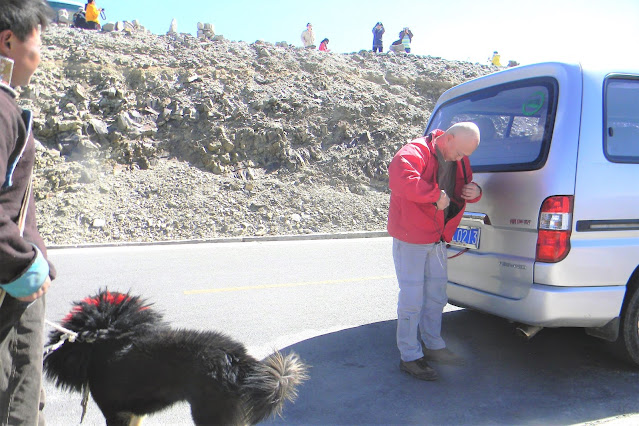
First stopped was at Kambala Pass (4700m). Ching Neng Bin had shaved bald for 8Y on second day in Lhasa. 
1st stopped at Kambala Pass (4700m) to take picture of the Yamdrok Lake at 4442m.
The
turquoise colored Yamdrok lake lies at 4447 meters/14,590 feet. You first see
the lake as you cross the 4700 meter/15,420 foot KambaLa Pass. In the
distance beyond the lake, you get a fantastic view of the glaciated peak
of Nojin Kangtsang rising to 7191 meters/23,593 feet.
Chew Siang Peng and Ching Neng Bin at Kambala Pass (4700m) to take picture of the Yamdrok Lake at 4447m.
Yamdrok Lake at 4447m has beautiful blue water and is surrounded by snow-capped mountains.
Descending from the Kamba La Pass, the road follows alongside Yamdrok Lake.
Our 2nd stopped was Yamdrok Lake at 4447m.
A giant black yak at Yamdrok Lake 4447m.
Chew Siang Peng at Yamdrok Lake at 4442m.
Driving alongside Yamdrok Lake towards Shigatse.
Descending from the Kamba La Pass, the road follows alongside Yamdrok Lake to the small town of Nakartse. 
Our 3rd stopped in this shop for lunch in Nangartse, a small town along the way to Shigatse. 
Leaving Nakartse, we continued driving east towards the Karola Glacier Pass (5,000m).
The Karola Glacier Pass (5,000m) at the base of Mt. Nojin Kangsang.
The Karola Glacier Pass (5,000m) at the base of Mt. Nojin Kangsang.
Our 4th stopped was to see the Karola Glacier Pass (5,000m), a
breathtaking view of the Karola Glacier in an unforgettable experience.
This Karola Glacier Pass (5,000m) serves as the
boundary between Lhoka prefecture and Shigatse prefecture (not to be
confused with the town of Shigatse). The high pass sits at the base of
Mt. Nojin Kangtsang, the same snow-capped peak viewed from above Yamdrok
Lake. From this pass, you can get a great view of the glaciers as they
stop just above the highway.
The Karola Glacier Pass (5,000m) at the base of Mt. Nojin Kangsang.
The Karola Glacier Pass (5,000m) at the base of Mt. Nojin Kangsang.
The country side view of farm land from Karola Glacier Pass at 5,000m to Shigatse at 4,025 meters.
The country side view of farm land from Karola Glacier Pass at 5,000m to Shigatse at 4,025 meters.
A tractor on the road to Shigatse.
The last pass was the Semela Pass (4,800m) with fantastic view of Yarlong Lake below on the road to Shigatse. 
The last pass was the Semela Pass (4,800m) with fantastic view of Yarlong Lake below on the road to Shigatse.
The last pass was the Semela Pass (4,800m) with fantastic view of Yarlong Lake below on the road to Shigatse. 
We finally arrived at Shigatse at 4pm and visited Tashilhunpo Monastery. The gate entrance to Tashilhunpo Monastery in Shigatse.

Tashilhunpo Monastery is one of the 6 main monasteries of the Yellow Hat Sect of Tibetan Buddhism and was founded in 1447. Before the Cultural Revolution there were more than 4000 monks in residence here. Now there are around 700. Tashilhunpo Monastery is the home monastery of the line of Panchen Lamas, the most influential line of lama’s in Tibet after the Dalai Lama. The tombs of the 5th through the 10th Panchen Lama’s are found within the huge monastery. Standing on the entrance of Tashilunpo, visitors can see the grand buildings with golden roofs and white walls. 
Chew Siang Peng and Ching Neng Bin at Tashilhunpo
Monastery in Shigatse.
Tashilhunpo
Monastery in Shigatse.
Tashilhunpo
Monastery in Shigatse.
Tashilhunpo
Monastery in Shigatse.
Tashilhunpo
Monastery in Shigatse.
Tashilhunpo
Monastery in Shigatse.
Tashilhunpo
Monastery in Shigatse.
Tashilhunpo
Monastery in Shigatse.
Chapel of Jamba (强巴佛殿), also called Maitreya Temple, is standing out in the east side of Tashilhunpo Monastery. First built in 1914 by the ninth Panchen Lama, it remains its great majesty and solemnity. Chapel of Jamba is a five-story palace with two winding corridors below. It is a fieldstone-lined chapel with a height of 30 meters and an area of 862 square meters. In Chapel of Jamba sits a gigantic statue of Maitreya, the future Buddha. Based on in the 3.8-meter high lotus-shaped foundation, this statue is the largest and tallest bronze figure of Buddha in the world, 26.2 meters high and 11.5 meters wide across shoulder. It was 110 craftsmen who spent 4 years building this great achievement. You can find valuable stones like diamonds, pearls and ambers inset in the body of the statue of Jamba apart from gold and brass going into his coating, showing followers’ deeply respect to him. There are also over 1,000 gold paintings of Jamba on the walls.
Chapel of Jamba, also called Maitreya Temple is standing out in the east side of Tashilhunpo Monastery.
Chapel of Jamba, also called Maitreya Temple is standing out in the east side of Tashilhunpo Monastery.
Chapel of Jamba, also called Maitreya Temple is standing out in the east side of Tashilhunpo Monastery. 
Chapel of Jamba, also called Maitreya Temple is standing out in the east side of Tashilhunpo Monastery. 
Had dinner at Songtsen Tibetan Restaurant in Shigatse. It has good Indian, Nepalese, Tibetan cuisine.
Entrance to Songtsen Tibetan Restaurant in Shigatse. It has good Indian, Nepalese, Tibetan cuisine.
Day 26 (14.04.2010) Shigatse to Lhasa
The return journey to
Lhasa was by way of the Friendship Highway arriving at 3pm. At 4.20pm we
met up with Chew's friend who is the number 2 man in the military. He
gave us a very special dinner together with his military officers in the
most famous Chinese restaurants in Lhasa - we talk on everything except
politics.
Sleeping: Mandala Hotel, No.31 South Barkhor St. -180Y a room for 2pax
The return journey from Shigatse to
Lhasa was by way of the Friendship Highway.
The return journey from Shigatse to
Lhasa was by way of the Friendship Highway.
The return journey from Shigatse to
Lhasa was by way of the Friendship Highway.
The return journey from Shigatse to
Lhasa was by way of the Friendship Highway.
The return journey from Shigatse to
Lhasa was by way of the Friendship Highway.
The return journey from Shigatse to
Lhasa was by way of the Friendship Highway.
The return journey from Shigatse to
Lhasa was by way of the Friendship Highway.
Our guide Mr. Tenzin Phuntsok took us to a shop along the highway from Shigatse to
Lhasa for lunch.
Our guide Mr. Tenzin Phuntsok took us to a shop along the highway from Shigatse to
Lhasa for lunch.
A typical farm house land along the way back to Lhasa behind the shophouse we had lunch.
A typical farm house land along the way back to Lhasa behind the shophouse we had lunch.
A typical farm house land along the way back to Lhasa behind the shophouse we had lunch.
Hotel and restaurant along the highway from Shigatse to
Lhasa for lunch.
Hotel and restaurant along the highway from Shigatse to
Lhasa for lunch.
The return journey from Shigatse to
Lhasa Barkhor Street was by way of the Friendship Highway arriving at 3pm. 
View of Barkhor Street from Mandala Hotel where we stayed in front of Jokhang Temple in Lhasa.
Very old twisted tree at Potala Square in Lhasa. 
Chew Siang Peng and Ching Neng Bin at Potala Square, Lhasa
Potala Square, Lhasa
Potala Palace, Lhasa.
The night view of Potala Palace, Lhasa.
At 4.20pm we
met up with Chew's friend who is the number 2 man in the military. He
gave us a very special dinner together with his military officers in the
most famous Chinese restaurants in Lhasa - we talk on everything except
politics.
At 4.20pm we
met up with Chew's friend who is the number 2 man in the military. He
gave us a very special dinner together with his military officers in the
most famous Chinese restaurants in Lhasa.
Day 27 (15.04.2010) Lhasa (day trip to Namtso Lake)
After breakfast at 8am, it was a four hour journey to Namtso Lake, about 230km north of Lhasa. The scenery was breathtaking but so is the altitude: 4,718m (110m higher than Lhasa). Had very good view of the Qinghai-Tibet Railway which was officially started operations on 1st July 2006.
Sleeping: Mandala Hotel, No.31 South Barkhor St. -180Y a room for 2pax

The scenery on the road to Namtso Lake was breathtaking at an altitude of 4,718m (110m higher than Lhasa).
The Qinghai-Tibet Railway line includes the Tanggula Pass at 5,072m above sea level, is the world's highest point on a railway. About 960 kilometers of it
are at an altitude of 4,000 meters above sea level.
The scenery on the road to Namtso Lake was breathtaking at an altitude of 4,718m (110m higher than Lhasa).
The scenery on the road to Namtso Lake was breathtaking at an altitude of 4,718m (110m higher than Lhasa).
We visited a Tibetan house in a village at the outskirt of Lhasa on the road to Namtso Lake.
We visited a Tibetan house in a village at the outskirt of Lhasa on the road to Namtso Lake.
We were welcomed by the ladu of the house and were served with the local tea. We got to know how local Tibetans live, and how beautiful nature is.
It was truly a memorable home visit at a local Tibetan home at the outskirt of Lhasa on the road to Namtso Lake.
Qinghai-Tibet Railway - The longest railway crossing on frozen-earth plateau with 550 kilometers built on a foundation of perennial and continually frozen ground.
Qinghai-Tibet Railway - The longest frozen-earth plateau tunnel in the world – Kunlun Mountain Tunnel, 1,686 meters long, at an average altitude of 4,600 meters and with temperatures as low as minus 30 degrees Celsius. The oxygen content of the air is half that in plain areas.
The scenery on the road to Namtso Lake was breathtaking at an altitude of 4,718m.
The scenery on the road to Namtso Lake was breathtaking at an altitude of 4,718m.
The scenery on the road to Namtso Lake was breathtaking at an altitude of 4,718m. 
The scenery on the road to Namtso Lake was breathtaking at an altitude of 4,718m.
The scenery on the road to Namtso Lake was breathtaking at an altitude of 4,718m.
The scenery on the road to Namtso Lake was breathtaking at an altitude of 4,718m.
The longest railway bridge on the line – Qingshuihe Bridge, 11.7 kilometers in length crossing Hoh Xil Nature Reserve at an average altitude of 4,600 meters.
The highest speed of any train on a plateau frozen-earth railway anywhere in the world. The Qinghai-Tibet train can reach speeds of 100 kilometers per hour on frozen-earth sections and up to 120 kilometers on other parts of the line. 
The Qinghai-Tibet Railway connects Tibet with the rest of China.
The Qinghai-Tibet Railway has boosted the economic and social development of Qinghai Province and the Tibet Autonomous Region and made traveling more convenient across the nation. Its construction showcases China's perseverance.
Sitting at an altitude of 4,718 metres, Namtso Lake (“Heavenly Lake”) is one of the three holy lakes of Tibet and has a surface area of 1,920 square kilometers. The lake has a striking blue color and stretches out seemingly forever in front of the dramatic snow-capped peaks of the Nyainqentanglha Mountain range. 
The scenery on the road to Namtso Lake was a beautiful scenery and views of typical Tibetan life along the way. The views of the North Tibet grasslands along the way and climb over the snow-capped Nyainqentanglha Mountains, including a stop at Lakenla Pass.
The Lakenla Pass offers magnificent views of
the surrounding mountains and Namtso Lake from a distance.
The Lakenla Pass offers magnificent views of
the surrounding mountains and Namtso Lake from a distance. 
The Lakenla Pass, at an elevation of 5,190m, offers magnificent views of
the surrounding mountains and Namtso Lake from a distance.
The scenery on the road from Lakenla Pass at 5,190m to Namtso Lake at 4,718m was breathtaking. 
The scenery on the road from Lakenla Pass at 5,190m to Namtso Lake at 4,718m was breathtaking.
The scenery on the road from Lakenla Pass at 5,190m to Namtso Lake at 4,718m was breathtaking.
Some of the pastoral nomads camping near to Namtso Lake.
A frozen river on the road to Namtso Lake.
Some of the pastoral nomads camping near to Namtso Lake.
Arrived at a small village in Namtso Lake for lunch.
A lady selling the Tibetan mastiff puppy dog at the small village in Namtso Lake.
Our tour guide bought the Tibetan mastiff puppy dog from the lady at Namtso Lake.
A Tibetan goat at Namtso Lake.
We had the most expensive lunch at this Wen Chuah Hotels in Namtso Lake. 
We had the most expensive lunch at this Wen Chuah Hotels in Namtso Lake. 
Upon reaching the Tashi peninsula of Namtso Lake, we took a
stroll along the shores of the lake and enjoy stunning views of the blue
lake with snow-covered mountains in the background.
There is also a
small temple at the end of the walk. There are yaks and horses on the
shores that visitors can ride and take pictures with for a small fee.
Namtso Lake daytime average temperature: -10°C, warm clothes such as outdoor fleece jackets, down jackets, windbreakers, sweaters, winter jackets, fur coats and leather jackets, etc. are recommended.
Namtso Lake is usually frozen with thick ice covered in the winter and spring. As the temperatures becoming lower, the snows turn into thick ice covering on the lake. The ice only starts to melt in May when tourists can hear loud noise of the ice fragmentation.
The lake is also believed to be the daughter of Indra, a guardian deity in Tibetan Buddhism who was the wife of Nyenchen Tanglha. Nyenchen Tanglha and his wife Namtso are soul-mates in Tibetan legends, who became more beautiful and magnificent the longer they spent together.
At the frozen Namtso Lake, the highest saltwater lake in the world at 4,718m was breathtaking. 
Ching Neng Bin at the frozen Namtso Lake, the highest saltwater lake in the world at 4,718m was breathtaking. 
Chew Siang Peng at the frozen Namtso Lake, the highest saltwater lake in the world at 4,718m was breathtaking.
Ching Neng Bin at the frozen Namtso Lake, the highest saltwater lake in the world at 4,718m was breathtaking.
Ching Neng Bin at the frozen Namtso Lake, the highest saltwater lake in the world at 4,718m was breathtaking.
Day 28 (16.04.2010) Lhasa to Chengdu
This was our last day in
Tibet. In the morning we visited the Jokhang Temple and after that Ching Neng Bin did
what a Tibetan would do and that is to prostrate in front of the 1,400
year old Jokhang temple. After lunch we packed our clothing and food that we do not need, we donated to the elderly people at Muru Monastery. We
have therefore duly completed our holy pilgrimage to the roof of the
world, "The Secret Tibet". Our guide picked us up at 2pm to airport
and our flight back to Chengdu at 4.30pm.
We got back to Traffic Inn at about 7.30pm. It was a big surprised for Ching at the Inn
when Sharon Tan and Chan Meng Fai who had also just came back from their Xian Tour, came to wish Ching 'Happy Birthday' when Ching himself had totally forgotten. Yes, it was Ching's
birthday alright!
Sleeping: Traffic Inn at 80Y a room for 2pax

We begin by entering through the Jokhang Temple main gate and passing by pilgrims
prostrating in front of the Temple. Four Guardian kings statues guard
the entrance to the temple. When we get to the courtyard, you can see
wall murals depicting the history of Buddhism. 
This Jokhang Temple was constructed in the middle of the 7th century by
the great Tibet King-Songsten Gampo. Is located in central Lhasa with an
area of 25,100 square meters (about 6 acres), it is the ultimate
pilgrimage destination for Tibetan Pilgrims.
Once inside, you will see the statues of Padma Sambhava (Guru
Rinpoche) and the Future Buddha (Maitreya) in the center of the main
hall. There are small chapels on all sides of the temple. Walking clockwise direction you can visit important
chapels, including Tsongkhapa, eight Medicine Buddhas,
and Avalokiteshvara.
The Jokhang Temple adopted the architectural styles of the Tang Dynasty, as well as those of Tibet and Nepal.
The Jokhang Temple adopted the architectural styles of the Tang Dynasty, as well as those of Tibet and Nepal.
The Jokhang Temple is a four-storey timber complex with a golden top.
The Jokhang Temple is a four-storey timber complex with a golden top.
In the eastern section of the Jokhang yard there are rows of lights
provide a path leading all the way to the main hall. The main hall, over
1,300 years old, is the oldest shrine of the complex.
In the eastern section of the Jokhang yard there are rows of lights provide a path leading all the way to the main hall. The main hall, over 1,300 years old, is the oldest shrine of the complex.
Offerings of prayers after the lighting of butter lamps is an integral part of Buddhist tradition.
The sacred image of Jowo Sakyamuni is the most venerated and beautiful image in all Tibet. Housed in the Jowo Lhakhang shrine (on the ground floor of the Jokhang Temple), the statue is 1.5 meters tall, cast from precious metals, and decorated with glittering jewels.

The view on the living quarters of the Dalai Lama in the Jokhang Temple.
The view on the living quarters of the Dalai Lama in the Jokhang Temple.
The view on the living quarters of the Dalai Lama in the Jokhang Temple.
Tibetan women singing folk songs and repairing the roof of Jokhang
Temple one of the holiest sites of Tibetan Buddhism and
listed on UNESCO world cultural heritage
Tibetan women singing folk songs and repairing the roof of Jokhang
Temple one of the holiest sites of Tibetan Buddhism and
listed on UNESCO world cultural heritage
Dharma Wheel (chakra) flanked by two deer. This represents the unity of all things and symbolizes Sakyamuni himself.
Architectural detail of the gilt roof and a Garuda and a dragon head on the Jokhang Buddhist temple in Lhasa, Tibet.
Golden lion statue with upturned eaves in Jokhang Temple.
Golden lion statue with upturned eaves in Jokhang Temple.
Dragon head on the Jokhang Buddhist temple in Lhasa, Tibet.
Carvings on the Jokhang Buddhist temple in Lhasa, Tibet.
A view of Barkhor Street from the roof top of Jokhang Temple.
Varied shops stand on both sides of the street and thousands of floating stands are on every corner. Most of them offer the prayer wheels, long-sleeve 'chuba' (the Tibetan people's traditional clothes), and religious articles for sale.
The Barkhor Street is a many-side-square region enclosing the Jokhang Temple. For tourists, it is a good place to explore local culture, and buy local articles. The entrance of Jokhang is located on the western street.
The Barkhor Street is a many-side-square region enclosing the Jokhang Temple.
Barkhor Street is a good place to explore local culture, and buy local articles.
Barkhor Street is a good place to explore local culture, and buy local articles.
Barkhor street surrounds the Jokhang Temple.

Barkhor street surrounds the Jokhang Temple.

Barkhor street surrounds the Jokhang Temple.

The Barkhor Street is a many-side-square enclosing the Jokhang Temple. For pilgrims, it is a sacred Kora path to circumambulate the Jokhang Temple which usually takes about 30 minutes to walk around.

Tibetan pilgrims prostrating themselves outside the Jokhang Temple.

Tibetan pilgrims prostrating themselves outside the Jokhang Temple.

Tibetan pilgrims prostrating themselves outside the Jokhang Temple.

Tibetan pilgrims prostrating themselves outside the Jokhang Temple.

Tibetan pilgrims prostrating themselves in front of the 1,400 year old Jokhang temple.

Tibetan pilgrims prostrating themselves in front of the 1,400 year old Jokhang temple.

Finally, it was Ching Neng Bin's turn to prostrate in front of Jokhang temple.

Finally, it was Ching Neng Bin's turn to prostrate and pray for world peace in front of the 1,400 year old Jokhang temple. Ching did 100 times in almost 30 minutes

Ching Neng Bin prostrated 100 times and pray for world peace in front of the 1,400 year old Jokhang temple in almost 30 minutes.

Ching Neng Bin prostrated 100 times and pray for world peace in front of the 1400 year old Jokhang temple in almost 30 minutes.

Ching Neng Bin prostrated 100 times and pray for world peace in front of the 1400 year old Jokhang temple in almost 30 minutes.

Ching Neng Bin prostrated 100 times and pray for world peace in front of the 1400 year old Jokhang temple in almost 30 minutes.

Ching Neng Bin prostrated 100 times and pray for world peace in front of the 1400 year old Jokhang temple in almost 30 minutes.

Ching Neng Bin said: "The 6-days trip to Tibet was my most fascinating, adventurers and curious destination I would imagine. And it has somehow changed my life a bit. The environment, the people, its culture, fate and destiny had a strong impact on my perception of the way of life in Tibet. On the second day in Tibet, I shaved my head bald and on the last day I did what the Tibetan would do; I prostrated 100 times at the Jokhang Temple for world peace. It somehow possesses some mystical spiritual experience as I entered the temples and monastery. View the special video below.
 Taking good rest at Traffic Inn and talk about our recent travel to Tibet and Xi’an by Chan Meng Fye and Sharon Tan.
Taking good rest at Traffic Inn and talk about our recent travel to Tibet and Xi’an by Chan Meng Fye and Sharon Tan. Traffic Inn office in Chengdu.
Traffic Inn office in Chengdu. Day 30 (18.04.2010) Chengdu to Kuala Lumpur
It was flight AirAsia touched down at LCCT at 4.30am and I slept at the bus-stand until 6.45am before taking my breakfast at the canteen. Took the 8am Star Shuttle bus (RM43) back to Ipoh.
Total expenses for 24 days adventure inclusive of air tickets to Sichuan and Yunnan was RM2,750-00 per person.
Total expenses for 6 days adventure inclusive of air tickets to Tibet was RM2,600-00 per person.
Part 2: Chengdu > Moxi > Hailuogou Glacier Park > Lu Ding > Chengdu > Panzhihua > Lijang > Jade Dragon Snow Mountain
Part 3: Lijiang > Xiatio > Tiger Leaping Gorge > Lijiang > Dali > Kunming > Chengdu
Part 4: Chengdu > Lhasa > Kuala Lumpur
///









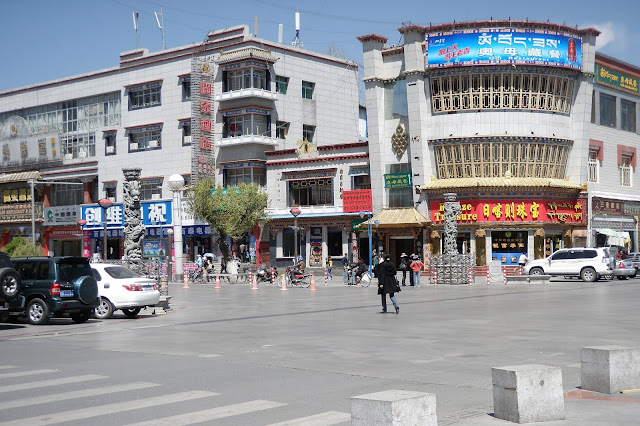





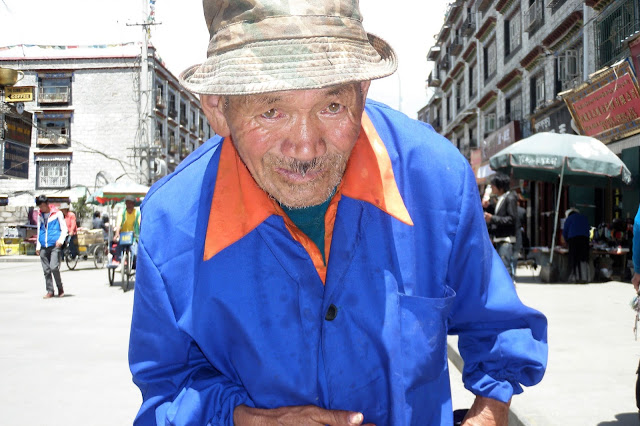













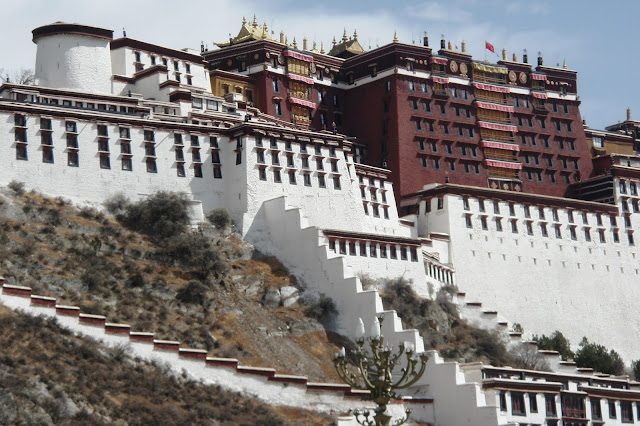






















































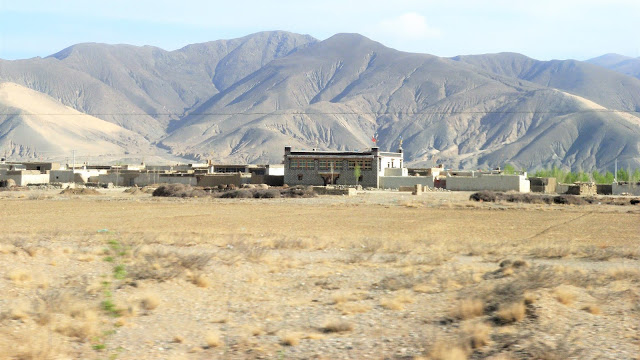




















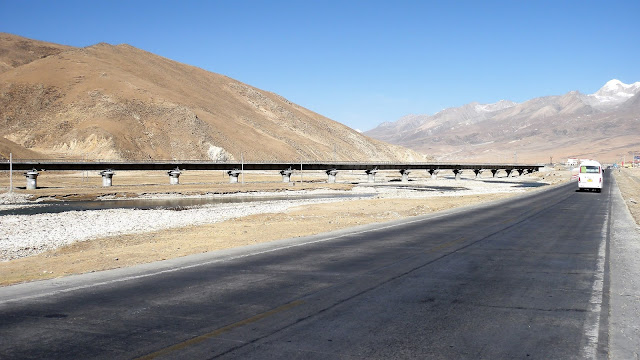






















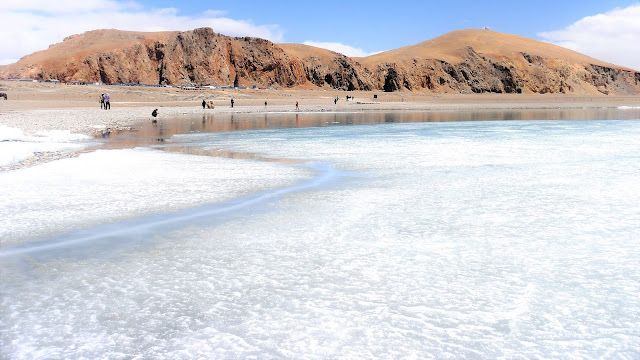
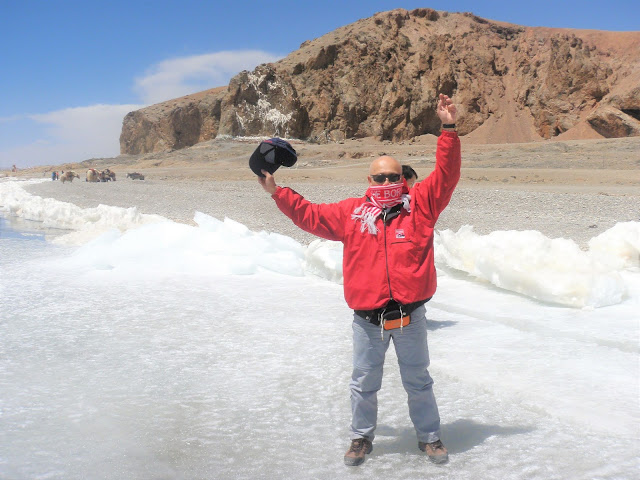






















Eye-opening experience for you & also for me as a reader of your write-up. Very detail & descriptive. I was very touched when I saw the video with you prostraing 100 times.
ReplyDeleteThanks for sharing. I've forwarded your link to many of my friends & they were all very impressed.
You must have taken a lot of photos. It is numerous.
ReplyDeleteWow , thks alot for sharing , Ching .
ReplyDeleteDream of making this trip in the not too distant future .
Such trips always adds abit more to our short sojourn in this earth .
cheers
TH Too
Thanks for sharing your trip, it was very details with well taken photos & descriptions. After seeing all the photos, I walk away with feeling like already toured Tibet although I never been there.
ReplyDeleteCongratulation for a Well documented tour experience.
Hi, Ching,
ReplyDeleteI feel excited to view your Blog. Full of facts, full of interesting articles and also full of adventurous events. Great !!! Also good to know that you went for Outward Bound School in 1975. One of your watch members, Nurul Azman, is actually from TNB. I went to OBS in 1966. Once again, Real Great Of You !!!
Dear Ching,
ReplyDeleteWe are glad, we cannot laugh at your bald head, and instead we admire your brave heart. Not everyone can do this. Congratulations on your successful trip. May God Bless you for the good deeds you have done.
Warmest regards,
Sally & Gunn
Awesome! I am truly touched by your experience. Your experience brought to my mind about God. It is true what He says about Love and Peace. About Love- ...God is love. (1 John 4:16). We love because He first loved us (1 John 4:19). About Peace- And the peace of God, which transcends all understanding, will guard your hearts and your minds in Christ Jesus. (1 Phillippians 4:7). Jesus Christ came in love and peace but the world did not recognise him and rejected him thus his persecution.The more I read about His words, the more I understand my purpose in life.
ReplyDeleteChing, I believe that you have been touched by God. What do you believe?
Love-in-Christ, Susan
Dear Ching,
ReplyDeleteThanks for sharing your adventure with me. Enjoyed the picture very much, only wished could joint you in one of your trip.
Best regards
Yoke Tek
Hi Ching
ReplyDeleteThanks for sharing your photos and videos on your trips overseas.It is indeed an eye opening experience for you and me by looking at the photos and the detail description.
Thank You
Dear Neng Bin
ReplyDeleteThis is the time, man ... nice to hear that you are enjoying and covering many places in this 30 days adventure which you truly and really deserve especially when you still have the stamina, energy and as usual the youthful vitality.
Good and continue to enjoy life to the fullest!!
Boon Kem
Public Bank
Dear Mr. Ching,
ReplyDeleteHow jealous I am and envy you guys. Happy touring and enjoy yourself. Regards to the team.
Regards,
Lee
Hey Ching,
ReplyDeleteI envy you. I am still sitting by the side of the Komoro River in East Timor! What a great trip.
Capt Wong
Visit Capt Wong's blog at
http://pythonjoe.blogspot.com/
Dear Ching & Kee Moon,
ReplyDeleteGlad to hear yours wonderful experience. Looking forward for more
interesting sharing.
God bless you.
Rtn.Siaw Fuang
Hi Ching,
ReplyDeleteIt's always great to receive your interesting news about your travel
itinerary. Wishing u a great holiday and great discoveries in your journey.
Best wishes,
Jackson
Dear Ching,
ReplyDeleteThank you for updating n wish I could join - you are making me envious. The trip is too long for me because currently I am working n can't get long leave - I had told Bernard about it. Please send my regards to all. Take care
Best regards,
Poh Geok
You all really have a good time enjoying out there breathing the natural fresh and unpolluted air up on the mountain . Enjoy to the fullest.
ReplyDeleteLawrence
wow, thanks mate, this is about a very vivid expose' of the Tibet expedition and I certainly would use this reference material in the future.......cheers!
ReplyDeleteNeng Bin,
ReplyDeleteWow, thanks a lot for sharing such wonderful trips. Dreams of making similar trip is impossible. Always add bit more to our 'self' making such trips in our short sojourn on this earth .
cheers!
TH Too
Dear Ching Neng Bin,
ReplyDeleteThank you indeed for sharing with us your excellent diary and photos of your amazing backpacking travels! :-)
I enjoyed viewing your photos and getting to know the places you've been, but as I browsed through your blog, some persistent questions kept popping up, and they are:-
1) To avoid getting lost in the vastness of China's mountains and hinterland, did you all hire a tour guide?
2) On the average, how many miles or kilometers did you all cover per day, and how often do you guys stop to take a rest?
3) Some of the terrain in your photos indicate that some parts are actually steep mountainous slopes. How high were they?
4) How many kilos did your back packs weigh on the average?
5) Did you all have any contingency plans in case someone fell down a sleep slope, or had an accident?
6) What if someone fell sick or had diarrhea? Do you all wait or leave him behind?
7) Was there an experienced medical officer, doctor who carried with him a well-stocked medical kit including urgent basic medication?
8) At all times, you knew exactly where you were and you also knew how far was the nearest hospital, pharmacy or civilization, right?
9) Do you have an experienced trekker who helped you planned your itinerary - including the most minute details?
Each of the tours last as long as a month. How much luggage can you all bring along especially seeing that over quite a fair part of the journey, everything has to be hand carried - at times over steep and difficult treks and terrain? I mean, I would presume you would need a change of fresh underwear at least once a day, but there is no laundry facilities over much of the journey to speak of! If you don't get a shower and a fresh change of underwear at least once every two days, then I can see you guys facing a health issue with itchy rashes and skin problems.
Apart from heavy jackets, woolens and thick underwear to keep out the cold, I imagine you need to pack a hundred other things like T-shirts, pants, towels, medicine, toiletries, comb, tooth paste and brush, eau de Cologne (in case you can't bathe or wash that day) tissue/toilet paper, GPS, maps,compass, sanitary towels and make-up (for females and some males) mob phone charges, at least a set of presentable clothing when you arrive in larger cities like Shanghai, reading material, eating utensils, rations, bottled water, etc., etc. So where is there space in your backpack and how much can you hand carry beyond 20 kilos with all that climbing as well?
Of course, backpackers get to see much more compared to travelers on a fully conducted tour. However, apart from this and the savings in costs, is it really worth it when considering the risks, inconveniences and discomfort and greater dangers involved?
Please do not take my questions in the wrong sense. I ask simply because I consider this as part of a learning and educational exercise for anyone considering to take up backpacking in a big way as you obviously have.
Kind regards,
Eddy(eddyc38@gmail.com)
Studying can be another smart way that will help you
ReplyDeleteselect the right gear for that trip to minimize discomfort and stress.
This excursion is pretty suitable for family
mainly because it brings different activities which will surely be well-liked by all
family members. But the most thrilling for those very first time
passengers will be the adrenaline felt at take-off.
Nice blog. Thanks for sharing informative content. If you are looking for professional Tibet tour operator for planning the details of your upcoming Tibet trip then you should definitely have to look here. GoToTibet.com, leading Tibet travel agencies offer a variety of private and small group Tibet tours, Tibet travel tips and information at an affordable budget price.
ReplyDelete